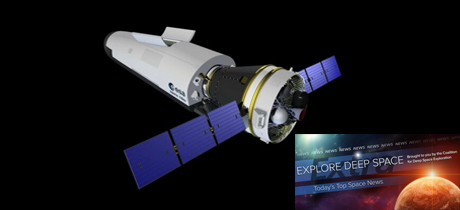New Episode of The Deep Space Podcast Available Now!
Join us for Episode 3 of the Deep Space Podcast’s Workforce of the Future Series, featuring Ty Lee, a systems engineer at Maxar and Sapna Rao, a systems engineer at Lockheed Martin. From museums to science fiction to astronauts, Ty and Sapna tell us about their sources of inspiration to pursue careers in space. Sapna and Ty also dive into the importance of space exploration for our planet and for humanity, and explain how the Orion next-generation spacecraft and the Gateway will contribute to sustainable missions to the Moon and future crewed trips to Mars. Click here to listen now.
In Today’s Deep Space Extra… International crew selected for Fall 2021 mission to the International Space Station (ISS). Japan confirms delivery of asteroid material from Hayabusa 2 sample return mission. U.S. national space policy update hailed as far reaching.
Human Space Exploration
NASA assigns astronauts for third SpaceX commercial crew mission
Coalition Member in the News – Boeing
SpaceNews.com (12/14): NASA and the European Space Agency (ESA) announced that NASA’s Raja Chari and Tom Marshburn, and ESA’s Matthias Maurer, have been selected to launch on the third of the planned SpaceX Crew Dragon missions to the International Space Station (ISS) planned for the Fall of 2021. Chari, an Air Force test pilot who will be launching for the first time, was one of 18 astronauts named by NASA on December 9 to participate in future Artemis mission to the Moon. Marshburn, a flight surgeon, will be launching to the Station for a third time. Maurer, also launching for the first time, is a materials scientist.
Space Science
JAXA: Black sand grains from asteroid Ryugu found in Hayabusa2 capsule
The Japan News (12/15): Hayabusa 2, the Japan Aerospace Exploration Agency’s (JAXA) six-year-long mission to the primitive asteroid Ryugu, deployed a sample container into remote Australia on December 6 as the mothership sped by Earth to another destination. Scientists in Japan are carefully opening the container and say it has so far revealed particles several millimeters in size and gases associated with the asteroid. Hayabusa 2 touched down twice at Ryugu over 2019.
Catch an awe-inspiring great conjunction of Jupiter and Saturn on December 21st
Universetoday.com (12/14): Already close together in the night sky at dusk this month, Jupiter and Saturn, the solar system’s two largest planets, will move even closer as December 21 approaches. The conjunction of the two planets happens about once every 20 years, though this one is especially close and will not be matched until March 15, 2080.
Opinion
What you may have missed in the new National Space Policy
Brookings Institute (12/14): The National Space Policy update issued by the Trump Administration last week refocuses America on the stars, writes Michael Sinclair, a Brookings federal executive fellow. “There is a Starship Enterprise’s worth of interesting content and no shortage of ground-breaking ideas in these documents. They’re all definitely worth a close read if you’re even a little bit interested in space issues,” he writes.
Other News
Biden team engaging with NASA, industry
Coalition Members in the News – Northrop Grumman, United Launch Alliance
Spacepolicyonline.com (12/15): The NASA transition review team appointed by President-elect Biden and led by Ellen Stofan, a former NASA chief scientist, is engaged with NASA and the aerospace industry.
167 million Euro Space Rider contract funds construction of Europe’s first orbital spaceplane
SpaceNews.com (12/11): The European Space Agency (ESA) is looking to mid to late 2023 for the inaugural launch of Space Rider, a robotic orbital space plane under development by Thales Alenia Space Italy and Avio, also of Italy. The two companies were selected earlier this month for the work under a $200 million contract in U.S. dollars. U.S. Space Rider, with its lifting body design, builds on a previous suborbital reentry vehicle that launched once in 2015 and will share a resemblance to the U.S. Air Force’s reusable X-37B spaceplane.

